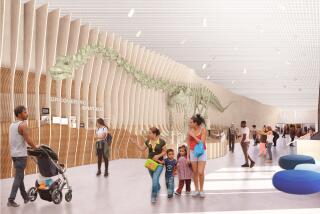Couple Keeps Dairy Barn for Dinos
- Share via
SUNBURY, Pa. — With its creaky wooden door and antique farm implements, the dairy barn on April and Barry James’ property promises to take visitors back in time. As for what’s inside, well, that takes you back even further.
It’s Giganotosaurus, stretching 48 feet from tip to tail--a carnivore that dwarfs even the renowned Tyrannosaurus rex. Bent down as if to examine its prey, Giganotosaurus is a chilling sight, even though the exposed skeleton is merely silicone and plastic on a steel frame.
“I want my creations to be as lifelike as possible,” Barry James said.
Through their business, Prehistoric Journeys, the Jameses have assembled more than 130 real and replica skeletons of dinosaurs and prehistoric mammals--and have built a solid reputation for their work.
Mark Hertig is the museum curator at the Agate Fossil Beds National Monument in the northwest corner of Nebraska, which displays six of the Jameses’ mammal replicas.
“When I’ve heard their name in the past, when we were creating these exhibits, it was always spoken with a great deal of admiration,” Hertig said. “They’re quite well known.”
Barry, who holds a master’s degree in vertebrate paleontology, and April, a fossil preparer, started Prehistoric Journeys 13 years ago using contacts they had made while working in museums. Both had found their museum jobs too limiting.
Ted Daeschler, a paleontologist with the Academy of Natural Science in Philadelphia, remembers visiting the Jameses in 1997 to examine their first Giganotosaurus, which now stands opposite the T. rex as the centerpiece of the academy’s dinosaur exhibit.
Within the walls of the old dairy barn near Sunbury in Northumberland County, Daeschler envisioned building a razor-toothed giant, crouched and ready to attack.
“That, I think, is the most important thing in a skeletal mount--it has to speak of a live thing, which is challenging to do when all you have is the bones,” Daeschler said. “It has to have some fluidity to it, some balance to it, some logic that hits you when you see if its head was turned that way, then its tail would be curved the other way.
“Walking in that big barn door and seeing that dinosaur in the main barn stall--that was cool as can be,” Daeschler said.
The new Giganotosaurus was one of two behemoths the Jameses worked on over the winter. The other was Bruno, an Argentinosaurus named for Barry James’ late friend and mentor, geologist Bruno Benson. Both replicas were cast from skeletons found in Argentina.
Argentinosaurus is the largest dinosaur discovered, standing 26 feet tall and stretching 100 feet from tip to tail--so big, in fact, that the Jameses had to seek outside help when building the steel frame that would support the fiberglass dinosaur.
“It was a very interesting project,” said Brian Chilton for State College-based Uni-Tec Consulting Engineers Inc., who worked with Marty Zahuranec to design the metal framework.
“We got an education about dinosaurs as well as we went along, just from learning about the bone structure, where we had room and where we didn’t, how things connected,” Chilton said.
The Jameses have assembled several complete skeletons for display, but most of their work is with replicas.
For the Agate Fossil Beds museum, the Jameses built two giant pigs and four chalicotheres, which Hertig said had a giraffe-like neck, the head of a horse and a claw-like hoof. “I saw once in a children’s book where it was described as a sort of spare parts animal,” Hertig said.
Skeletal remains of the chalicothere, which lived 20 million years ago, are rare, which is why replicas like those the Jameses created are valuable to museums.
“There are only so many original fossils, and actually oftentimes it’s just partial fragments of animals that lead to their identification and naming, so whole skeletons are very rare,” Hertig said. “With the chalicothere, I’m sure there are a few around the world, but I would guess there are not dozens, at least not in the complete state.”
With limited original material to work with, replica manufacturers need to be creative in portraying how the animals acted and looked, he said.
The Giganotosaurus--the fifth assembled by the Jameses, but the first free-standing specimen--is bound for Cocoa Beach, Fla.-based Paleofun, which develops traveling exhibits for museums throughout the Southeast.
The Academy of Natural Sciences: https://www.acnatsci.org/
Agate Fossil Beds National Monument: https://www.nps.gov/agfo
Fernbank Museum of Natural History: https://www.fernbank.edu/museum/index.html
Paleofun: https://www.paleofun.com
More to Read
Sign up for The Wild
We’ll help you find the best places to hike, bike and run, as well as the perfect silent spots for meditation and yoga.
You may occasionally receive promotional content from the Los Angeles Times.






